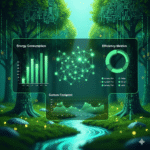Smart glasses with contextual AI assistance are redefining wearable technology, offering hands-free, intuitive support in daily life. As of July 01, 2025, these devices leverage artificial intelligence (AI) to provide real-time information tailored to the user’s environment, marking a significant leap in personal tech. This article explores their rise, key features, applications, challenges, and future potential, providing a critical perspective on their impact in 2025.
The Rise of Smart Glasses with Contextual AI Assistance
The surge of smart glasses with contextual AI assistance in 2025 reflects growing demand for seamless, context-aware tools. Building on early models like Google Glass, devices such as Meta’s Ray-Ban Meta and emerging Android XR prototypes integrate AI to interpret surroundings. Industry enthusiasm highlights their potential to replace smartphones for certain tasks, with sales exceeding expectations—Meta sold over 1 million units in 2024—fueling a shift toward practical, stylish wearables.
Key Features and Technologies
These glasses use AI to process multimodal inputs—cameras, microphones, and sensors—to deliver contextual aid. Features include real-time translation, navigation overlays, and object recognition, powered by models like GPT-4o and Meta AI. Hardware advancements, such as lightweight designs and Snapdragon processors in RayNeo X2, enable on-device processing, reducing latency. The integration of edge computing ensures data stays local, enhancing privacy and responsiveness, a key focus in 2025’s tech landscape.
Applications Across Industries
The smart glasses with contextual AI assistance are transforming sectors:
- Healthcare: Doctors use them for hands-free diagnostics, with AI suggesting treatments based on patient visuals. This diagnostic support is enhanced by emotionally intelligent AI, as explored in our article on AI agents with adaptive emotional intelligence and real-time collaboration, which highlights empathetic tech.
- Retail: Shoppers receive product details and price comparisons in-store.
- Travel: Real-time translation aids international navigation and communication.
- Manufacturing: Workers access assembly instructions overlaid on equipment.
Driving Forces Behind Adoption
Factors driving this trend include the rise of remote work, with 40% of jobs hybrid by 2025, and 5G/6G connectivity enabling low-latency AI. Consumer demand for hands-free productivity, alongside investments in AR hardware—over $3 billion in 2024—propels growth. Regulatory support, like the EU’s AI Act, encourages responsible development, aligning with a user-centric tech future.

Challenges and Ethical Concerns
Despite their promise, challenges arise. Privacy risks escalate with constant camera use, risking breaches if security lags. Battery life remains limited, with most devices needing frequent charging. The environmental impact of manufacturing advanced components contradicts sustainability goals, often downplayed. Similar sustainability challenges apply to web technologies, as explored in our article on AI-powered Progressive Web Applications (PWAs) with offline capabilities, which examines eco-friendly design. Accuracy of contextual AI varies, potentially misinterpreting complex scenarios, raising ethical questions about reliability.
A Critical Perspective
The narrative of smart glasses with contextual AI assistance as a productivity revolution is compelling, but it masks flaws. The focus on convenience overlooks privacy vulnerabilities, with past camera-based breaches eroding trust. The sustainability claim is undermined by production energy costs, clashing with green tech ideals. Accuracy issues and battery limitations question their all-day practicality, while high costs may exclude budget-conscious users, favoring tech elites. True progress requires balancing innovation with privacy, sustainability, and accessibility beyond the hype.
The Future of Smart Glasses
The future is bright, with the market projected to reach $5 billion by 2027. By 2026, 30% of professionals may adopt these glasses, driven by lighter designs and AI enhancements. Regulatory clarity will be key, but success hinges on addressing privacy, environmental, and inclusivity challenges to benefit a broader audience. Advances in battery technology and AI accuracy could further solidify their role, though equitable pricing remains a hurdle to overcome.





